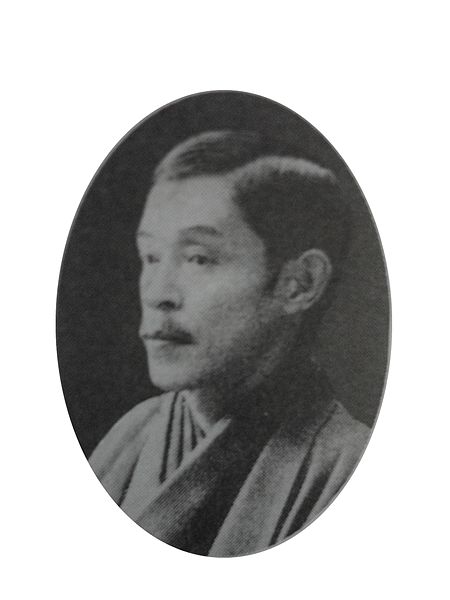| |
TERAZAKI Kôgyô(1866 - 1919)Biography
TERAZAKI Kôgyô, Picture from his Mortuary |
|
| |
||
Artist – Kôgyô
TERAZAKI (寺崎 広業, 1866 – 1919), was a Japanese painter
and printmaker in the Meiji and Taisho eras. Kôgyô
TERAZAKI as a printmaker is mainly known for
Kuchi-e. After having established himself as a painter and
printmaker, the artist worked as a professor at the
Imperial School of Arts in Tokyo. Kôgyô TERAZAKI
mainly drew historical pictures in the Meiji era, though,
his main subjects of drawing came to landscape views. His
landscapes show the delicate Japanese style and colouring,
yet at the same time they also show Western influence. He
was mainly a painter, but he also produced woodblock
prints of bijin, kacho-e and war prints of the
Russo-Japanese war, where he served as a war
correspondent. Kôgyô TERAZAKI
often signed his prints as Sōzan (秀山).
When he was 16 years old, he started studying painting under Komuro Hidetoshi of the Kano school. In 1888, Kôgyô went to Tokyo and became a pupil of Hirafuku Hoan of the Shijo school. Okakura Tenshin who was in a position of the director of the Tokyo School of Fine Arts (Tokyo Bijutsu Gakko) found Kôgyô's talent and he invited Kôgyô for an assistant professor of that school in 1898. Though, next year, Tenshin was kept away from the school so that Kôgyô also left the school. Tenshin established the Japan Art Institute (Nihon Bijutsu-In), and Kôgyô participated in that institute together with Hashimoto Gaho, Yokoyama Taikan, Shimomura Kanzan and others. In 1901, Kôgyô came back to a professor of the Tokyo School of Fine Arts. In 1904, as the Russo-Japanese War occurred, he joined the Imperial Army of Japan as a painter. In 1907, he sent his work to the first Bunten Exhibition, and, he also became a judge of the exhibition. He was accepted for the subsequest Bunten Exhibitions several times. He was also an appointed member of the Art Committee of the Imperial Household.
Personal life - Kôgyô was born in Dewa Province (present day Akita Prefecture) as a son of an executive Samurai. He had at least two brothers. His grandfather served in the Akita Domain as a chief retainer (Karo). However, after the Meiji Restoration in 1868, his father failed in business and Kôgyô had many hardships. Kôgyô moved to Tokyo in 1888. At the age of 19 he became a secretary in the registry office of the Ani goldmines. After stabilizing his family's financial situation, he moved to Tokyo and once again started his career as an artist. Nevertheless his main profession was lecturer, assistant professor and professor in different art institutions. In 1892 he was married to his wife Mukojima (向島). There is so far no information about issues. In February 1919 he died of throat cacer. He was buried in the Soto Sosenji Temple in the Itabashi-ku ward of Tokyo.
Aliases - Kôgyô TERAZAKI (寺崎 広業), Sōzan
Disciples - none known
zurueck zur Hauptseite / back to main page
When he was 16 years old, he started studying painting under Komuro Hidetoshi of the Kano school. In 1888, Kôgyô went to Tokyo and became a pupil of Hirafuku Hoan of the Shijo school. Okakura Tenshin who was in a position of the director of the Tokyo School of Fine Arts (Tokyo Bijutsu Gakko) found Kôgyô's talent and he invited Kôgyô for an assistant professor of that school in 1898. Though, next year, Tenshin was kept away from the school so that Kôgyô also left the school. Tenshin established the Japan Art Institute (Nihon Bijutsu-In), and Kôgyô participated in that institute together with Hashimoto Gaho, Yokoyama Taikan, Shimomura Kanzan and others. In 1901, Kôgyô came back to a professor of the Tokyo School of Fine Arts. In 1904, as the Russo-Japanese War occurred, he joined the Imperial Army of Japan as a painter. In 1907, he sent his work to the first Bunten Exhibition, and, he also became a judge of the exhibition. He was accepted for the subsequest Bunten Exhibitions several times. He was also an appointed member of the Art Committee of the Imperial Household.
Personal life - Kôgyô was born in Dewa Province (present day Akita Prefecture) as a son of an executive Samurai. He had at least two brothers. His grandfather served in the Akita Domain as a chief retainer (Karo). However, after the Meiji Restoration in 1868, his father failed in business and Kôgyô had many hardships. Kôgyô moved to Tokyo in 1888. At the age of 19 he became a secretary in the registry office of the Ani goldmines. After stabilizing his family's financial situation, he moved to Tokyo and once again started his career as an artist. Nevertheless his main profession was lecturer, assistant professor and professor in different art institutions. In 1892 he was married to his wife Mukojima (向島). There is so far no information about issues. In February 1919 he died of throat cacer. He was buried in the Soto Sosenji Temple in the Itabashi-ku ward of Tokyo.
Aliases - Kôgyô TERAZAKI (寺崎 広業), Sōzan
Disciples - none known
Copyright 2008 ff: Hans P. Boehme